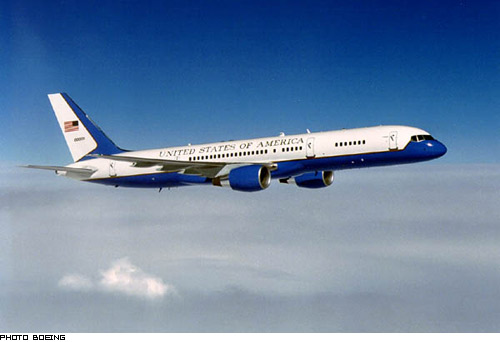C-32
Summary
| Category | Military Transport Aircraft |
| Origin country | 🇺🇸 United States |
| Manufacturer | Boeing |
| First flight | 1 June 1998 |
| Year introduced | 1998 |
| Number produced | 6 units |
| Average unit price | $90 million |
Description
The C-32A is the military designation for the Boeing 757-2G4, a modified version of the Boeing 757-200 mid-size, narrow-body twin-engine jet airliner adapted for government VIP transport. This adaptation includes changes to a 45-passenger interior and military avionics. In August 1996, a contract was awarded for four aircraft to replace the aging fleet of VC-137 aircraft. The first C-32A was delivered to the 89th Airlift Wing at Andrews Air Force Base, Maryland, in late June 1998.
The C-32A aircraft are distinguished by the blue and white livery developed for Air Force One, including the vertical stabilizer flag and "UNITED STATES OF AMERICA" cheatline markings. They are equipped with Pratt & Whitney PW2000 engines and winglets for increased fuel efficiency. Interiors include new carpets, lighting, leather seats, and wood tables. The C-32A is not designed for combat and is not equipped with any weapons systems.
The C-32B variant is significantly different, designed for ultra-long-range clandestine support. It is outfitted with advanced communications and enlarged fuel tanks extending its unrefueled range to 6,000 nmi (6,900 mi; 11,000 km). It features an aerial refueling capability via a Universal Aerial Refueling Receptacle Slipway Installation (UARRSI) and an airstair for independent passenger egress. It includes a winch-based baggage loading system for operations in austere environments and an advanced Multi-Role Tactical Common Data Link (MR-TCDL) communications suite. The C-32B supports clandestine missions; according to Air Force Manual 11-2C-32B (2020), at least two members of the aircrew are always armed. The C-32B's primary purpose is to transport personnel and equipment, with most cargo stowed in the rear of the aircraft due to the enlarged fuel tanks replacing much of the below-deck cargo hold.
The C-32A has been in operation with the 1st Airlift Squadron of the 89th Airlift Wing since its introduction in 1998. It is primarily utilized for transporting high-ranking government officials, including the vice president (as Air Force Two), the first lady, and members of the Cabinet and Congress. It also serves as Air Force One when the president travels to destinations unsuitable for the larger VC-25As. Over its service life, several C-32As have experienced equipment failures during VIP transport missions, leading to premature returns to base. The C-32A is not planned to leave service until 2040. The C-32B supports Foreign Emergency Support Team missions and classified special operations and intelligence missions worldwide.
Main Variants:
-
C-32A: This variant, based on the Boeing 757-200, is used for government VIP transport, featuring a 45-passenger interior and specialized military avionics.
-
C-32B Gatekeeper: This version provides clandestine airlift for special operations and emergency response, equipped with advanced communications and extended range.
Technical specifications
| Version: C-32 | |
|---|---|
| Crew | 16 (depending on missions) |
| Operational range | 10,200 km (6,338 mi) |
| Maximum speed | 853 km/h (530 mph) |
| Wing area | 181.3 m² (1951.0 sqft) |
| Wingspan | 38.0 m (124.6 ft) |
| Height | 11.0 m (36.2 ft) |
| Length | 47.3 m (155.2 ft) |
| Service ceiling | 12,802 m (42,001 ft) |
| Empty weight | 58,900 kg (129,852 lbs) |
| Max. takeoff weight | 115,666 kg (255,000 lbs) |
| Powerplant | 2 x turbojet Pratt & Whitney PW2040 delivering 18915 kgf each |
Current operating countries
All operators
